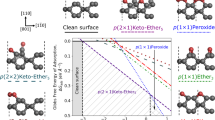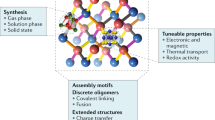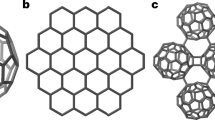Abstract
Diamondoids are a unique form of carbon nanostructure best described as hydrogen-terminated diamond molecules1. Their diamond-cage structures and tetrahedral s p3 hybrid bonding create new possibilities for tuning electronic bandgaps, optical properties, thermal transport and mechanical strength at the nanoscale1,2. The recently discovered higher diamondoids3,4 have thus generated much excitement in regards to their potential versatility as nanoscale devices5,6,7,8,9,10,11,12,13,14,15. Despite this excitement, however, very little is known about the properties of isolated diamondoids on metal surfaces, a very relevant system for molecular electronics. For example, it is unclear how the microscopic characteristics of molecular orbitals and local electron–vibrational coupling affect electron conduction, emission and energy transfer in the diamondoids. Here, we report the first single-molecule study of tetramantane diamondoids on Au(111) using scanning tunnelling microscopy and spectroscopy. We find that the diamondoid electronic structure and electron–vibrational coupling exhibit unique and unexpected spatial correlations characterized by pronounced nodal structure across the molecular surfaces. Ab initio pseudopotential density functional calculations reveal that much of the observed electronic and vibronic properties of diamondoids are determined by surface hydrogen terminations, a feature having important implications for designing future diamondoid-based molecular devices.
This is a preview of subscription content, access via your institution
Access options
Subscribe to this journal
Receive 12 print issues and online access
$259.00 per year
only $21.58 per issue
Buy this article
- Purchase on Springer Link
- Instant access to full article PDF
Prices may be subject to local taxes which are calculated during checkout




Similar content being viewed by others
References
Marchand, A. P. Diamondoid hydrocarbons—delving into nature’s bounty. Science 299, 52–53 (2003).
Raty, J. Y. & Galli, G. Ultradispersity of diamond at the nanoscale. Nature Mater. 2, 792–795 (2003).
Dahl, J. E., Liu, S. G. & Carlson, R. M. K. Isolation and structure of higher diamondoids, nanometer-sized diamond molecules. Science 299, 96–99 (2003).
Dahl, J. E. et al. Isolation and structural proof of the large diamond molecule, cyclohexamantane (C26H30). Angew. Chem. Int. Edn 42, 2040–2044 (2003).
McIntosh, G. C., Yoon, M., Berber, S. & Tomanek, D. Diamond fragments as building blocks of functional nanostructures. Phys. Rev. B 70, 045401 (2004).
Drummond, N. D., Williamson, A. J., Needs, R. J. & Galli, G. Electron emission from diamondoids: A diffusion quantum Monte Carlo study. Phys. Rev. Lett. 95, 096801 (2005).
Lu, A. J., Pan, B. C. & Han, J. G. Electronic and vibrational properties of diamondlike hydrocarbons. Phys. Rev. B 72, 035447 (2005).
Richardson, S. L., Baruah, T., Mehl, M. J. & Pederson, M. R. Theoretical confirmation of the experimental Raman spectra of the lower-order diamondoid molecule: Cyclohexamantane (C26H30). Chem. Phys. Lett. 403, 83–88 (2005).
Willey, T. M. et al. Molecular limits to the quantum confinement model in diamond clusters. Phys. Rev. Lett. 95, 113401 (2005).
Filik, J. et al. Raman spectroscopy of nanocrystalline diamond: An ab initio approach. Phys. Rev. B 74, 035423 (2006).
Fokin, A. A. et al. Reactivity of [1(2,3)4]pentamantane (T-d-pentamantane): A nanoscale model of diamond. J. Org. Chem. 71, 8532–8540 (2006).
Oomens, J. et al. Infrared spectroscopic investigation of higher diamondoids. J. Mol. Spectrosc. 238, 158–167 (2006).
Schreiner, P. R. et al. Functionalized nanodiamonds: Triamantane and [121]tetramantane. J. Org. Chem. 71, 6709–6720 (2006).
Willey, T. M. et al. Observation of quantum confinement in the occupied states of diamond clusters. Phys. Rev. B 74, 205432 (2006).
Yang, W. L. et al. Monochromatic electron photoemission from diamondoid monolayers. Science 316, 1460–1462 (2007).
Eigler, D. M. & Schweizer, E. K. Positioning single atoms with a scanning tunnelling microscope. Nature 344, 524–526 (1990).
Stipe, B. C., Rezaei, M. A. & Ho, W. Single-molecule vibrational spectroscopy and microscopy. Science 280, 1732–1735 (1998).
Ho, W. Single-molecule chemistry. J. Chem. Phys. 117, 11033–11061 (2002).
Kirtley, J. R., Washburn, S. & Scalapino, D. J. Origin of the linear tunneling conductance background. Phys. Rev. B 46, 336–346 (1992).
Stipe, B. C., Rezaei, H. A. & Ho, W. Localization of inelastic tunneling and the determination of atomic-scale structure with chemical specificity. Phys. Rev. Lett. 82, 1724–1727 (1999).
Hahn, J. R., Lee, H. J. & Ho, W. Electronic resonance and symmetry in single-molecule inelastic electron tunneling. Phys. Rev. Lett. 85, 1914–1917 (2000).
Grobis, M. et al. Spatially dependent inelastic tunneling in a single metallofullerene. Phys. Rev. Lett. 94, 136802 (2005).
Lorente, N. & Persson, M. Theory of single molecule vibrational spectroscopy and microscopy. Phys. Rev. Lett. 85, 2997–3000 (2000).
Ihm, J., Zunger, A. & Cohen, M. L. Momentum-space formalism for the total energy of solids. J. Phys. C 12, 4409–4422 (1979).
Soler, J. M. et al. The SIESTA method for ab initio order-N materials simulation. J. Phys. Condens. Matter 14, 2745–2779 (2002).
Hybertsen, M. S. & Louie, S. G. Electron correlation in semiconductors and insulators: Band gaps and quasiparticle energies. Phys. Rev. B 34, 5390–5413 (1986).
Jorgensen, W. L. & Salem, L. The Organic Chemist’s Book of Orbitals (Academic, New York, 1973).
Perdew, J. P. & Zunger, A. Self-interaction correction to density-functional approximations for many-electron systems. Phys. Rev. B 23, 5048–5079 (1981).
Troullier, N. & Martins, J. L. Efficient pseudopotentials for plane-wave calculations. Phys. Rev. B 43, 1993–2006 (1991).
Acknowledgements
This work was supported in part by NSF Grant Nos. DMR04-39768, EEC-0425914, COINS, UC Discovery grant ELE 05-10234, and the US Department of Energy under Contract No. DE-AC02-05CH11231. Computational resources have been provided by DOE at the National Energy Research Scientific Computing Center. Y.W. thanks the Miller Institute for a research fellowship. E.K. is a fellow of the Onassis Foundation. D.W. acknowledges support by the Alexander von Humboldt Foundation.
Author information
Authors and Affiliations
Corresponding authors
Supplementary information
Supplementary Information
Supplementary information and supplementary figure 1 (PDF 115 kb)
Rights and permissions
About this article
Cite this article
Wang, Y., Kioupakis, E., Lu, X. et al. Spatially resolved electronic and vibronic properties of single diamondoid molecules. Nature Mater 7, 38–42 (2008). https://doi.org/10.1038/nmat2066
Received:
Accepted:
Published:
Issue Date:
DOI: https://doi.org/10.1038/nmat2066
This article is cited by
-
Nanohybrid-based immunosensor prepared for Helicobacter pylori BabA antigen detection through immobilized antibody assembly with @ Pdnano/rGO/PEDOT sensing platform
Scientific Reports (2020)
-
Assigning the absolute configuration of single aliphatic molecules by visual inspection
Nature Communications (2018)
-
Effects of functionalization on the electronic and absorption properties of the smaller diamondoids: a computational study
Journal of Chemical Sciences (2018)
-
Unconventional molecule-resolved current rectification in diamondoid–fullerene hybrids
Nature Communications (2014)
-
Computational study of adamantanes using floating basis functions
Structural Chemistry (2014)



